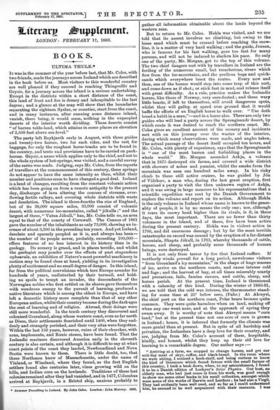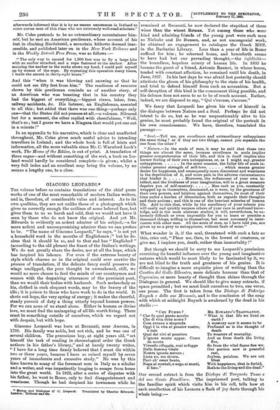BOOKS.
ULTIMA THULE.* IT was in the summer of the year before last, that Mr. Coles, with two friends, made the journeys across Iceland which are described in the book before us. Most visitors to this wonderful country are well pleased if they succeed in reaching Thingvellir and Geysir, for a journey across the island is a serious undertaking.
Except in the districts within a short distance of the coast, this land of frost and fire is dreary and inhospitable to the last degree ; and a glance at the map will show that the boundaries separating the eighteen Syslar, or counties; start from the coast, and in many instances, after running some distance inland, vanish, there being, it would seem, nothing in the unpeopled deserts of the interior worth dividing. These deserts consist "of barren table-land, which attains in some places an elevation of 2,500 feet above sea-level."
The party left Reykjavik early in August, with three guides and twenty-two horses, two for each rider, and the rest, for baggage, for only the roughest horse-tracks are to be found in the country, and tents and provisions have to be carried on pack- horses. Greysir, a name which applies only to the chief, and not to the whole system of hot-springs, was visited, and a careful survey of the series was made. Judging, says Mr. Coles, from the reports of travellers at the commencement of this century, these springs do not appear to have the same intensity as then, whilst their number and positions seem to have changed a good deal. Iceland is a land of changes, resulting from the constant volcanic action which has been going on from a remote antiquity to the present day, discharges of lava altering the courses of streams, over- flowing fertile valleys, and covering whole districts with waste and desolation. The island is three-fourths the size of England, but of its 38,000 square miles, 33,000 consist of volcanic desert, with numerous ice-mountains, called " jokulls ;" and the largest of these, " Vatna Jokull," has, Mr. Coles tells us, an area equal to that of the county of Cornwall. The Census of 1881 gave the number of the inhabitants as only 73,000, showing an in- crease of about 3,300 in the preceding ten years. And yet Iceland, desolate and sparsely peopled as it is, and always has been— the number of its people never, probably, exceeding 100,000— offers features of no less interest in its history than in its geology. Its scenery is grand, and in places terrific, and whilst the geologist may ponder over the effects of past stupendous upheavals, an exhibition of Nature's most powerful machinery in motion may be found close at hand, yielding in its investigation plenty of excitement and no small degree of danger. In this island, far from the political convulsions which tore Europe asunder for hundreds of years, undisturbed by their turmoil, and hold- ing no spoils to tempt an invader, the descendants of the Norwegian nobles who first settled on its shores gave themselves with wondrous energy to the pursuit of learning, produced a native literature which is among the oldest in Europe, and have left a domestic history more complete than that of any other European nation, whilst their country became during the dark ages the seat of learning and of religion. Abroad, their doings were still more wonderful. In the tenth century they discovered and colonised Greenland, along whose western coast, even as far north as Disco, their settlements flourished until 1409, when they sud- denly and strangely perished, and their very sites were forgotten. Within the last 150 years, however, rains of their churches, with urns, implements, and Runic stones, have been found. That the Icelandic mariners discovered America early in the eleventh century is also certain, and although it is difficult to say at what exact points of the coast they landed, Newfoundland and Nova Scotia were known to them. There is little doubt, too, that these Northmen knew of Massachusetts, under the name of Vinland, or Wineland, where they found, as the first English settlers found also centuries later, vines growing wild on the hills, and Indian corn on the lowlands. Traditions of these lost colonies remained after they had vanished, and in 1477, Columbus arrived at Reykjavik, in a Bristol ship, anxious probably to * Summer Travelling in Iceland. By John Coles. London: John Murray. ISM
gather all information obtainable about the lands beyond the
western seas.
But to return to Mr. Coles. Hekla was visited, and we are told, that its ascent involves no climbing, but owing to the loose sand which must be crossed before reaching the snow- line, it is a matter of very hard walking ; and the guide, Jonson, who is famous for his fast walking, goes too fast for many persons, and will not be induced to slacken his pace. So only one of the party, Mr. Morgan, got to the top of this volcano. The two chief dangers met with by travellers in Iceland are the fording of the numerous small, but treacherous, rivers which flow from the ice-mountains, and the perilous bogs and quick- sands which everywhere beset the routes. Every now and then, one of the horses would step into some trap of this sort, and come down as if shot ; or stick fast in mud, and release itself with great difficulty. As a rule, practice makes the Icelandic horses, like those of Norway, very sure-footed ; and these wary little beasts, if left to themselves, will avoid dangerous spots, whilst they will gallop at speed over ground that it would baffle the efforts of an English horse to walk over. "Use cloth breed a habit in a man,"—and in a horse also. There are only two guides who will lead a party across the Sprengisandr desert, by which route it was desired to reach the northern coast. Mr. Coles gives an excellent account of the scenery and incidents met with on this journey over the wastes of the interior, during which many observations were made, and angles taken.
The actual passage of the desert itself occupied ten hours, and Mr. Coles, with plenty of experience, says that the Sprengisandr is "one of the most barren and forbidding places in the whole world." Mr. Morgan ascended Askja, a volcano that in 1875 destroyed six farms, and covered a wide district with showers of ashes and pumice, whilst the smoke from the
mountain was seen one hundred miles away. In his risky
climb to these still active craters, he was guided by Jon of Vidrkcer, a man who, during the last great eruption, first organised a party to visit the then unknown region of Askja, and it was owing in large measure to his representations that a scientific expedition was sent by the Danish Government to explore the volcano and report on its action. Although Hekla is the only volcano in Iceland whose name is known to the gener- ality of people, it is by no means the only one ; nor, although it rears its snowy head higher than its rivals, is it, in these days, the most important. There are no fewer than thirty volcanoes in the island, and of these, five have been active daring the present century. Hekla was in violent action in 1766, and did enormous damage ; but by far the most terrible catastrophe on record was caused by the eruption of a far-distant mountain, Skapta J5kall, in 1783, whereby thousands of cattle, horses, and sheep, and probably some thousands of human beings, were destroyed.
It is not only from terror by fire that Iceland suffers. If northerly winds prevail for a long period, unwelcome visitors "from Greenland's icy mountains," in the shape of huge masses of ice, arrive on the northern coasts, and cause intense cold and fogs ; and the harvest of hay, at all times miserably scanty and precarious, fails, famine ensues, and cattle, sheep, and horses perish. At the present time, Iceland is threatened with a calamity of this kind. Daring the winter of 1880-81, we are told that the cold was intense, the thermometer stand- ing for some time at 25° below zero, (Fahr.) At Akreyri, the chief port on the northern coast, Polar bears became quite common. They were quite harmless when on land, making off when any one went near, and at the approach of spring they swam away. It is worthy of note that Akreyri means "corn land," but at the present time not one acre of corn is grown
in Iceland ; hence, it is inferred that formerly the climate was more genial than at present. But in spite of all hardship and privation, the Icelanders have a deep love for their country, and are, judging from Mr. Coles's account of them, hospitable, kindly, and honest, whilst they keep up their old love for learning to a remarkable degree. Our author says :— " Arriving at a farm, we stopped to change horses and get our mid-day meal of skyr, coffee, and black-bread. In the room where we were Bitting, I noticed a book-shelf, and being curious to know the kind of literature which found favour with the small farmer of this country, I took a book down when, to my astonishment, I found it to be a Danish edition of Lockyer's Solar Physics. Our host, an elderly man, who had just come in from his work, was good enough to show me some other books in his small collection, amongst which were some of the works of Darwin and Larclner ; be had also a Virgil. They had evidently been well used, and so far as I could understand him, he seemed to be well acquainted with their contents. I was
afterwards informed that it is by no means uncommon in Iceland to come acmes men of this class who are extremely well-read scholars."
Mr. Coles pretends to be no extraordinary mountaineer him- self, but he met an American gentleman, whose account of his feat in climbing Herdahreid, a mountain hitherto deemed inac- cessible, and pnblished later on in the New York Tribune and in the Weekly Detroit Free Press, was as follows :— "The only way to ascend for 1,500 feet was to fly a large kite with an anchor attached, and a rope fastened to the anchor. After Bemiring the anchor to the rocks above my head, I could pull myself up by means of the rope. By repeating this operation many times, I made the ascent in thirty-eight hours."
And this "when it was blowing and snowing so that he
could not see fifty feet from him." The readiness of resource shown by this gentleman reminds us of another story, of an American who was boasting that in his country they
had the biggest of everything,—biggest rivers, lakes, fires, -railway accidents, &e. His listener, an Englishman, assented to all this ; but added that there was one thing—perhaps only one—that the States did not possess at all,—a volcano. Silenced but for a moment, the other replied with cheerfulness, "Well, that's so ; but I guess we have a Niagara that would put one out in a minute !"
In an appendix to his narrative, which is clear and unaffected throughout, Mr. Coles gives much useful advice to intending travellers in Iceland; and the whole book is full of hints and information, all the more valuable since Mr. C. Warnford Lock's work, The Home of the _Mao, is out of print. A translation of three sagas—and without something of the sort, a book on Ice- land would hardly be considered complete—is given; whilst a very full index and an excellent map bring the volume, by no means a lengthy one, to a close.















































 Previous page
Previous page